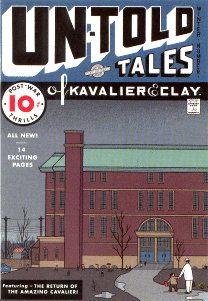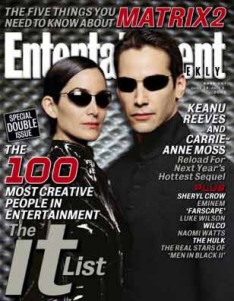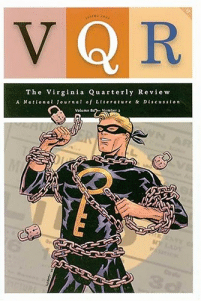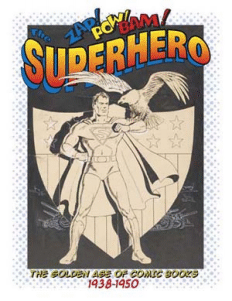Untold Tales
Missing chapters. Unwritten stories. First drafts. When you think about it, Michael Chabon probably an entire book’s worth of unpublished Kavalier & Clay stories, and over the past few years, our favorite writer has been kind enough to release some of these “untold tales” for our reading consumption. Below, a list of all known untold tales.
 “The Return of the Amazing Cavalieri: From Untold Tales of Kavalier & Clay.”
“The Return of the Amazing Cavalieri: From Untold Tales of Kavalier & Clay.”
Printed in McSweeney’s #7. McSweeney’s Quarterly, 2001.
I spent several months hunting down a copy of McSweeney’s #7 because it is now out of stock unfortunately. It’s a great set of little booklets, by various writers, but the main reason I bought it was for the sixteen-page story titled “The Return of the Amazing Cavalieri: From Untold Tales of Kavalier & Clay.”
Taking place a little after the events of the novel, the story features Kavalier attempting to impress Tommy’s class by performing an escape. Of course, the simple escape does not go the way it should.
I would love to know why Chabon chose to write this, because I’m not sure if this was intended to be the original last chapter of the novel or if he wrote it for his own amusement. Either way, it is a good thing that it is a seperate entity. Although the story is nice and fun, it does nothing to build on Kavalier & Clay. Although Kavalier’s relationship with Tommy is explored, the only difference between their relationship in this story and their relationship in the novel is that now Kavalier is Tommy’s only father figure.
Still, the story is a fun one. I hope that someday an edition of the novel will be released that will included this story and some of Chabon’s other related writings (such as “The Recipe for Life”), but I know that won’t happen for like another twenty years. Ah well.
 Sammy and Rosa’s Wedding
Sammy and Rosa’s Wedding
Printed in Entertainment Weekly, June 28/July 5, 2002, p. 44.
For the Kavalier & Clay movie, Chabon had to pick and choose what scenes were absolutely necessary. After all, the book was huge, far too epic for even two or three hours. “A lot of things about the book are really a pain in the neck,” he told EW. “The story takes place over this huge span of time. There’s an 11-year gap in the middle when we don’t see the characters at all. Then there’s the whole comic-book thing…. I wrote the first draft of the screenplay from memory, as if there were no novel at all and I were just remembering a story that I had heard…. Much less time passes in the movie than in the book. It’s really just the period of the war.”
But that didn’t mean Chabon couldn’t add a few new scenes here and there, such as Sammy and Rosa’s wedding. “This is just after Joe Kavalier has learned of his brother’s death and goes off on the spur of the moment and joins the Navy,” Chabon said. “He’s left Rosa behind and she’s pregnant. At the same time Sammy is left with no one either. So Rosa and Sam end up making a marriage of convenience.”
“I had the feeling a few times that, this ought to have been in the book. That’s definitely the way I felt about this little wedding scene between Sammy and Rosa. I had a good time writing it.”
To read the one-page scene, click here.
 “An Untold Tale of Kavalier & Clay: Breakfast in the Wreck.”
“An Untold Tale of Kavalier & Clay: Breakfast in the Wreck.”
Printed in The Virginia Quarterly Review, Spring 2004, 80, no. 2, p. 33-38.
During the 1950’s, Sammy took up several “not-quite-affairs” with various men, including little Tommy’s fifth-grade teacher, Mr. Landauer. This story is a cut chapter from the original novel and takes place the day immediately following Sammy’s testimony in the Kefauver hearings.
In the unpublished chapter, Sammy and Felix Lander discuss over breakfast the day’s preceding events. Sammy tells Felix that he’s actually happy about what happened. Sammy also discusses his disappointment with his career, but Felix disagrees, arguing that Sammy is lucky to be able to have lived a life of creativity and fantasy.
Unlike the previous untold tale, this story takes place before the original novel ends and as a result does contribute new information about our favorite characters. I myself had actually though Sammy had had sexual affairs with his men friends; perhaps that was bad reading on my part. Nevertheless, this story does broaden the reader’s understanding of how Sammy’s life after the war was.
Still, this isn’t a perfect story. Personally, I feel that the characters’ conversation reveals too much too soon about how Sammy feels about his public outing, which is far more important to the novel than what he did with his men friends.
 “A Postscript.”
“A Postscript.”
Printed in Zap! Pow! Bam! The Superhero: The Golden Age of Comic Books, 1938-1950, November 2004, p. 35-39.
Imagine going to June 1988’s IronCon, where Sam Clay and Rosa Kavalier sit, signing autographs and selling drawings for $50. Both now well into their old-age, they travel sans Joe Kavalier, whom Rosa married only a year earlier after he was diagnosed with cancer. A reporter with The New Yorker sits down with the two for an interview, covering the entirety of their careers.
Chabon likely wrote the piece, an “apocryphal epilog” to the original novel, before the current Escapist comic series, which explains several inconsistancies with the cannon history. According to the story, Empire Comics’ assets fell into DC Comics’ lap after the infamous lawsuit, and DC revived the Escapist in the 70s during the “nostalgia craze.” After that, the character remained at DC, and in the late 80s appeared in his own monthly (and violent) comic series. Of course, in the Dark Horse series, Escapist fell into the hands of numerous companies, none (so far) being DC.
While readers may debate the consistancy of the missing chapter, they will also find surprising revelations about what happened to their favorite characters. Rosa’s drawing career ended in the late 60s after getting arthritis. She lived with Joe for years, raising Thomas and a second son, Ethan. Thomas grew up to become the amazing “Cavalieri,” a stage escape artist who has performed numerous times on Johnny Carson’s show. Ethan followed his parents’ footsteps, drawing for Marvel and DC before establishing his own independent company, Nuthouse Comics. Sammy established a “kind of combination credit union, flop house and soup kitchen” for starving comic artists.
Although a fun read, don’t turn to this one for the feel of Kavalier & Clay, only the characters. The story, written as a magazine article in first-person, lacks the voice of the original novel. Turn to the other two untold tales if that’s what you’re looking for. But, still, this is a good, fun read.